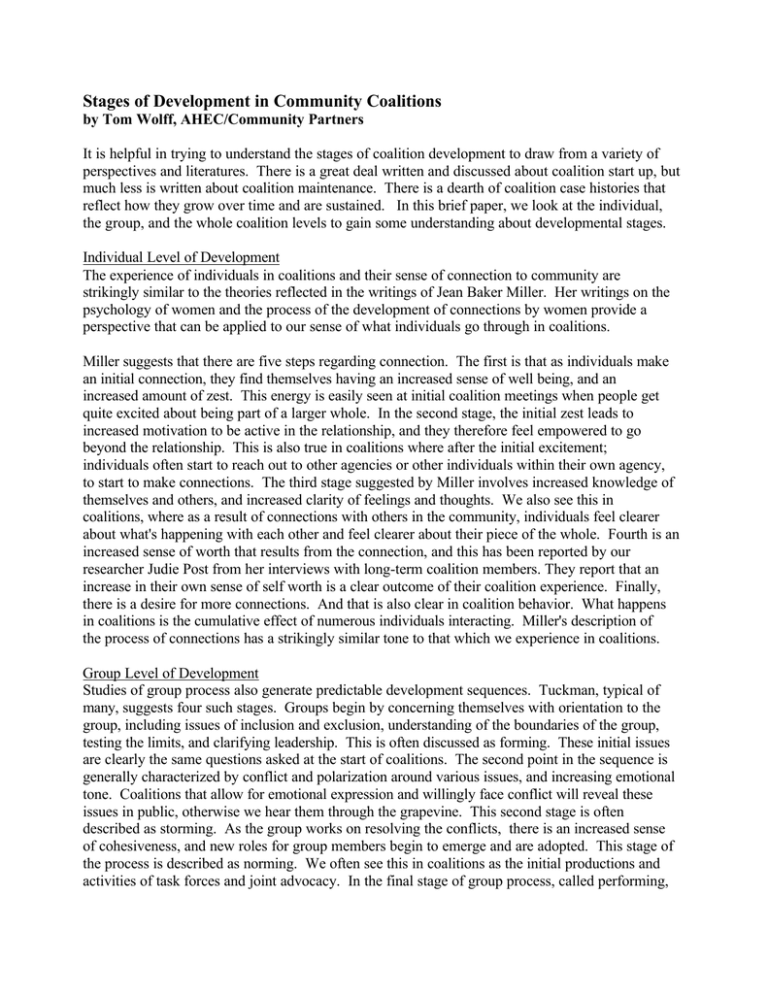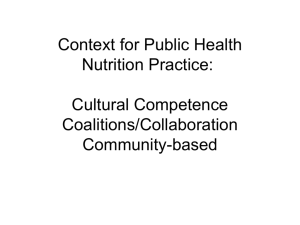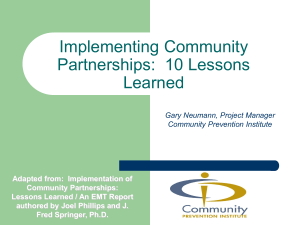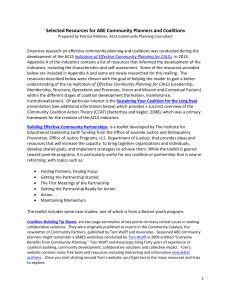Stages of Development in Community Coalitions
advertisement

Stages of Development in Community Coalitions by Tom Wolff, AHEC/Community Partners It is helpful in trying to understand the stages of coalition development to draw from a variety of perspectives and literatures. There is a great deal written and discussed about coalition start up, but much less is written about coalition maintenance. There is a dearth of coalition case histories that reflect how they grow over time and are sustained. In this brief paper, we look at the individual, the group, and the whole coalition levels to gain some understanding about developmental stages. Individual Level of Development The experience of individuals in coalitions and their sense of connection to community are strikingly similar to the theories reflected in the writings of Jean Baker Miller. Her writings on the psychology of women and the process of the development of connections by women provide a perspective that can be applied to our sense of what individuals go through in coalitions. Miller suggests that there are five steps regarding connection. The first is that as individuals make an initial connection, they find themselves having an increased sense of well being, and an increased amount of zest. This energy is easily seen at initial coalition meetings when people get quite excited about being part of a larger whole. In the second stage, the initial zest leads to increased motivation to be active in the relationship, and they therefore feel empowered to go beyond the relationship. This is also true in coalitions where after the initial excitement; individuals often start to reach out to other agencies or other individuals within their own agency, to start to make connections. The third stage suggested by Miller involves increased knowledge of themselves and others, and increased clarity of feelings and thoughts. We also see this in coalitions, where as a result of connections with others in the community, individuals feel clearer about what's happening with each other and feel clearer about their piece of the whole. Fourth is an increased sense of worth that results from the connection, and this has been reported by our researcher Judie Post from her interviews with long-term coalition members. They report that an increase in their own sense of self worth is a clear outcome of their coalition experience. Finally, there is a desire for more connections. And that is also clear in coalition behavior. What happens in coalitions is the cumulative effect of numerous individuals interacting. Miller's description of the process of connections has a strikingly similar tone to that which we experience in coalitions. Group Level of Development Studies of group process also generate predictable development sequences. Tuckman, typical of many, suggests four such stages. Groups begin by concerning themselves with orientation to the group, including issues of inclusion and exclusion, understanding of the boundaries of the group, testing the limits, and clarifying leadership. This is often discussed as forming. These initial issues are clearly the same questions asked at the start of coalitions. The second point in the sequence is generally characterized by conflict and polarization around various issues, and increasing emotional tone. Coalitions that allow for emotional expression and willingly face conflict will reveal these issues in public, otherwise we hear them through the grapevine. This second stage is often described as storming. As the group works on resolving the conflicts, there is an increased sense of cohesiveness, and new roles for group members begin to emerge and are adopted. This stage of the process is described as norming. We often see this in coalitions as the initial productions and activities of task forces and joint advocacy. In the final stage of group process, called performing, the group becomes much more functional, the group's energy is channeled into appropriate tasks, structural issues have been resolved, and the structure can now be supportive of getting the tasks done. Successful coalitions have been able to create structures that allow them to function, and also to get past the interpersonal conflicts, so that they can perform - as described in the group process literature. Coalition Level Development In her book Collaboration, Barbara Grey writes expansively about the stages of development of whole coalitions in collaborative efforts. Grey suggests three phases. Phase one is the problem setting phase, in which stakeholders are identified and their issues of mutual concern are acknowledged. The specific tasks that need accomplishment within the problem setting phase include: • • • • stakeholders must identify that their actions are dependent upon the actions of each other; stakeholders that are identified must represent a wide variety of the key components of the community and must be perceived as being legitimate stakeholders; a legitimate and skilled convener with process capacity must be identified and given authority to have the role of convener, and; all the stakeholders must agree that their shared vision and direction is of great enough value to outweigh the costs of such an effort. For coalitions, this translates to the kinds of issues and statements one hears early on, such as, "why should we do this", "what do we have in common", "is it worth it", "we've tried this before, it doesn't work", "what can we really achieve", and often ending with, "I'll try it, but no promises". Grey calls her second phase the direction setting phase, in which stakeholders identify their common purpose, and the values which underlie these pursuits. It is here that mutually agreed upon directions start to emerge, and the dispersion of power begins to occur among the stakeholders. In coalitions, we see this as a period of time when the mission, goals and objectives are articulated, the leadership structure becomes defined, the specific leaders identified, and the coalitions start to take their first mutual actions. The third stage Grey labels as the structuring phase. Here, the coalition begins to function in a systematic matter, and develops clear regulative functions. They begin to take their first actions which reinforce their beliefs that joint action can be beneficial; they begin to get some external recognition and mandate; and they begin to see the fruits of their labor. In coalition work, this becomes a critical phase and indeed can not be put off for too long. Stakeholders join coalitions tentatively, waiting to see whether indeed this new organization will have results, and unless early actions occur, they tend to be easily discouraged. Beyond Grey's three stages come the major questions of coalition maintenance. If we are collaborating on a specific effort, the campaign wins or loses and the coalition dissolves, maybe to be picked up again some time in the future. In contrast, other coalitions including AHEC/Community Partners have lasted as long as ten years; then issues of maintenance become critical. Long term coalitions must reassess community needs, redefine priorities, engage new members and re-engage old ones. They need to develop coalition rituals and events that reinforce the values and the connections made through coalition work. Coalitions need to be very flexible, and not only respond in a planned, thoughtful manner, but also be available to deal with emerging crises as they occur. Throughout the history of a coalition, the cost-benefit ratio for participants must be attended to. We cannot become so busy with programs that we forget to ask all coalition members whether they are getting what they want. Most of all, maintaining this kind of process requires skilled staff, who in turn need to have solid support and guidance from knowledgeable supervisors. All of the above are the beginnings of ideas about how coalitions develop over time. Ours is still a very rudimentary understanding to which we all can add through case studies and longitudinal evaluations. 1. Grey, B. (1989) Collaborating. Jossey-Bass: San Francisco 2. Miller, J.B. (1988) Connections, disconnections and violation. Work in Progress, No. 33. Wellesley, MA: Stone Center Working Paper Series. 3. Post, J. (1992) Survey Assessment of Area Health Education Center's Community Coalitions. AHEC/Community Partners: Amherst. 3. Tuckman, B. (1965) "Developmental sequence in small groups" Psychological Bulletin, Vol 63, #6, p384-399.








